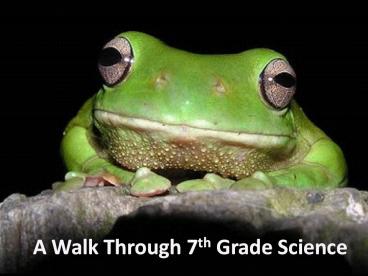A Walk Through 7th Grade Science PowerPoint PPT Presentation
1 / 37
Title: A Walk Through 7th Grade Science
1
A Walk Through 7th Grade Science
2
Interactions of Living Things
- Abiotic vs. Biotic
BIOTIC Living factor. Animals, plants, bacteria.
ABIOTIC Nonliving factor. Light, water, heat,
rocks, energy, minerals.
3
Interactions of Living Things
- Dichotomous Key
- An aid that is used to identify organisms based
on the answers to a series of questions.
4
Interactions of Living Things
- Ecosystem A community of living organisms and
their interrelated physical and chemical
environment.
5
Interactions of Living Things
- Biological Diversity The variety and complexity
of species present and interacting in an
ecosystem and the relative abundance of each. - BIOLOGICAL DIVERSITY IS A GOOD THING!
6
Interactions of Living Things
- Niche The role played by an organism in an
ecosystem its food preferences, requirements for
shelter, special behaviors and interactions with
other organisms in its habitat.
7
Interactions of Living Things
- Trophic Levels
What happens to the amount of energy?
- Producer
- Herbivore
- Carnivore
- Consumer
- Omnivore
8
Interactions of Living Things
9
Interactions of Living Things
- Equilibrium The ability of an ecosystem to
maintain stability among its biological
resources. - Homeostasis The tendency for a system to remain
in a state of equilibrium by resisting change.
10
Plants
- Photosynthesis Process by which plants, algae,
and some bacteria use sunlight, carbon dioxide,
and water to make food.
11
Plants
- Chlorophyll A green pigment that captures light
energy for photosynthesis. - This is what makes plants green!
- Stomata Opening in a leaf that allows gas
exchange. - Transpiration The process by which plants
release water vapor into the air.
12
Cycles
- Carbon Cycle
13
Cycles
- Water Cycle
14
Cycles
- Succession The series of changes that occur in
an ecosystem with the passing of time.
15
Cells
- Cell The smallest unit that can perform all life
processes. - Cell Cycle The life cycle of a cell.
16
Cells
- Cell Theory
- All living things are composed of cells
- Cells are the basic function and structure of
life - All cells come from other cells
17
Cells
- Prokaryotic vs. Eukaryotic
No Nucleus!
18
Cells
- Cell Processes
- Diffusion movement of particles from region of
high density to low density - Osmosis movement of water through a membrane
- Active Transport moving substances across cell
membrane (requires ENERGY from cell) - Passive Transport moving substances across cell
membrane (no energy required) - Enzymes protein that speeds up a chemical
reaction
19
Mitosis and Meiosis
20
Cells
- In case you thought cells were boring
- http//www.youtube.com/watch?v-zafJKbMPA8
- What are the two different types of cells?
- Plant and Animal
- What are the components of cells called?
- Organelles
- Which organelle controls the cell?
- Nucleus
21
Levels of Organization
22
Types of Reproduction
23
Guess the Type of Reproduction
Cloning
Mitotic Cell Division
Regeneration
Vegetative Reproduction
Budding
Fission
24
Structure Function
25
Heredity
- Dominant Trait - CAPITAL LETTERS
- Recessive Trait lower case letters
- Co-Dominance mixture of both
- Example
- In purple people eaters, one-horn is dominant and
no horns is recessive. - One-horn H
- No horns h
26
Heredity
- How creepy is this?
- What are the two possible genotypes for this
people eater (he has one horn).
- Homozygous Same allele
- Heterozygous Different alleles
- Example
- In purple people eaters, one-horn is dominant and
no horns is recessive. - Homozygous HH or hh
- Heterozygous Hh
27
Heredity Brain Pop!
28
Quiz Yourself!
29
Quiz Yourself!
30
Quiz Yourself!
31
Quiz Yourself!
32
Practice a Punnett Square
- One flower is heterozygous red (Rr) and it is
crossed with a homozygous white (rr) plant. Use a
Punnett square to determine the probability of
one of their offspring having a red color.
R
r
r
Rr
rr
50 Rr ? Red 50 rr ? White
r
Rr
rr
Genotype vs. Phenotype
33
Genetics - Pedigrees
34
Genetics
- Mutation a change in a gene.
35
Evolution
- Adaptation A characteristic that improves an
individuals ability to survive and reproduce in
a particular environment.
36
Evolution
- Evolution The process in which inherited
characteristics within a population change over
generations such that new species sometimes arise.
37
Natural Selection
- The process by which individuals that are better
adapted to their environment survive and
reproduce more successfully than less adapted
individuals do.

